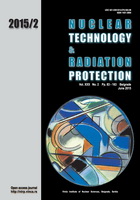
X-RAY PHOTOELECTRON SPECTRA STRUCTURE AND CHEMICAL BONDING IN AmO2
Pages: 83-98
Authors: Yury A.Teterin, Konstantin I. Maslakov, Mikhail V. Ryzhkov, Anton Yu. Teterin, Kirill E. Ivanov, Stepan N. Kalmykov, and Vladimir G. Petrov
Abstract
Quantitative analysis was done of the X-ray photoelectron spectra structure in the binding energy range of 0 eV to ~35 eV for americium dioxide (AmO2) valence electrons. The binding energies and structure of the core electronic shells (~35 eV-1250 eV), as well as the relativistic discrete variation calculation results for the Am63O216 and AmO8 (D4h) cluster reflecting Am close environment in AmO2 were taken into account. The experimental data show that the many-body effects and the multiplet splitting contribute to the spectral structure much less than the effects of formation of the outer (0-~15 eV binding energy) and the inner (~15 eV-~35 eV binding energy) valence molecular orbitals. The filled Am 5f electronic states were shown to form in the AmO2 valence band. The Am 6p electrons participate in formation of both the inner and the outer valence molecular orbitals (bands). The filled Am 6p3/2 and the O 2s electronic shells were found to make the largest contributions to the formation of the inner valence molecular orbitals. Contributions of electrons from different molecular orbitals to the chemical bond in the AmO8 cluster were evaluated. Composition and sequence order of molecular orbitals in the binding energy range 0-~35 eV in AmO2 were established. The experimental and theoretical data allowed a quantitative scheme of molecular orbitals for AmO2, which is fundamental for both understanding the chemical bond nature in americium dioxide and the interpretation of other X-ray spectra of AmO2.
Key words: actinide, X-ray, photoelectron spectrum, valence molecular orbital
FULL PAPER IN PDF FORMAT (2.04 MB)
